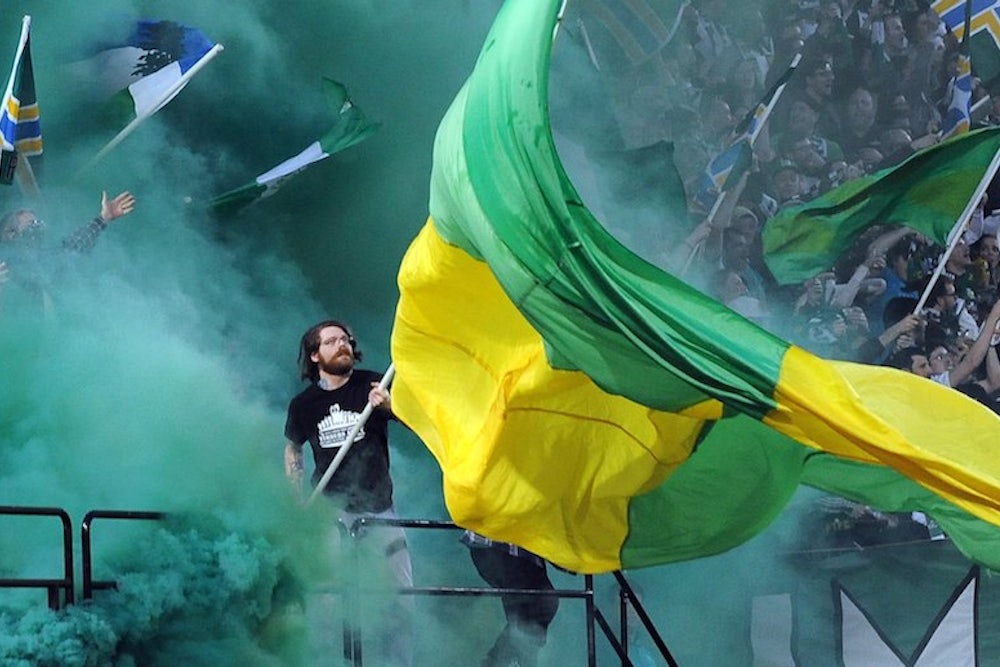One day after the world’s most popular soccer federation, the English Premier League, concluded a madcap season with (sigh) another Manchester City title, Major League Soccer, America’s homegrown league, will announce a new broadcast-rights deal that appears to be the next step toward increasing its prominence. According to Sports Business Journal, ESPN and Fox’s new eight-year English-language deal with the league, which kicks in next year, is worth $600 million, or $75 million a year. Combine that with a new Spanish-language agreement with Univision, and MLS’s domestic broadcast rights will rise from $18 million to $90 million a year, with most of that growth coming in the English-language rights deals.
Just as importantly, notes The New York Times, there will be a “game of the week” on Friday nights for Univision and a doubleheader on Sunday evenings, at 5 P.M. and 7 P.M. for ESPN2 and Fox Sports 1. “M.L.S. has long craved such ‘destination viewing’ windows,” the Times reports. “The league has said its research shows that even its most dedicated fans sometimes have little idea when the games are on.” One need only glance at the history of the National Football League to see why such a beachhead is important: That league began to explode on television only once it had a dedicated ABC timeslot on Monday nights.
Some perspective is in order. ESPN pays the NFL $1.9 billion a year for the privilege of broadcasting Monday Night Football. In other words, 16 football games on one network cost 21 times what more than 100 soccer games on three networks cost. The National Hockey League’s Canadian deal is worth magnitudes more than the MLS’s windfall.
So where does this leave the MLS? And how can it continue to grow? The American Football League, founded in 1960, grabbed fans with deep pockets (its chief founder was oil heir Lamar Hunt) and flashy stars (Joe Namath), and thereby forced a merger with the establishment NFL within a decade. The American Basketball Association, founded in 1967, achieved a merger in a similar timeframe by exploiting the National Basketball Association’s financial wobbliness and throwing in a red-white-and-blue ball and a three-point line. The MLS has no such advantages. The major European leagues—England’s Premier League, Spain’s La Liga, Germany’s Bundesliga, Italy’s Serie A, and France’s Ligue 1—contain some of the sports world’s most valuable franchises and all of the sport’s flashiest stars, and exist where their sport is the most popular. AFL-like attempts to outspend would prompt laughter from the likes of Chelsea’s Roman Abramovich or the money-minting top Spanish teams. And ABA-like attemps to innovate—no offside rule? larger goals?—would offend American soccer purists, who are the most anal set of aficionados this side of the baseball people.
The North American Soccer League had a brief bout of glory in the 1970s, but it flamed out. Its iconic moment was the New York Cosmos’ signing of an aging Pele for $2.8 million over three seasons. More recently, the similarly aging David Beckham netted $50 million—and just 18 goals—over five seasons with the MLS’s Los Angeles Galaxy. Clearly big spending is not the solution, and anyway a strict salary cap—and financial worries—will likely preclude such excesses.
One ingredient for MLS success is managed expectations. “The league has been around since 1996,” U.S. Soccer Federation president Sunil Gulati told me several months ago, “and if you’d said to those of us who were involved 17 years ago, ‘You’re going to build a league, and by 2013 you’re going to have 19 teams in Canada and the U.S. averaging 18,000 people with 13 soccer-specific stadiums having been built over the last 14 years, with multiple players on the national team,’ and on and on and on, then I would say, ‘We’ll take that.’”
But the other part might be precisely its intrinsically underdog and homegrown ethos. The future of the league is less likely to lie with clubs like New York’s forthcoming N.Y.C.F.C.—primarily owned by City, itself owned by Abu Dhabi’s royal family, with a small stake owned by America’s own symbol of decadent nepotism, the New York Yankees—and more with clubs that have spontaneously caught on in their home cities: Toronto F.C.; Sporting Kansas City; the Pacific Northwest trio of the Portland Timbers, Seattle Sounders, and Vancouver Whitecaps.
At the risk of sounding like somebody pitching an ad campaign for Brooklyn, MLS’s advantage is its local, personal, even craft sensibility. You can wear an Arsenal jersey in the streets of Washington, D.C., but you can’t see them in league competition by hopping on the Metro to RFK Stadium. You can watch the EPL in Portland, but you might have to wake up at 5:30 in the morning. By contrast, now you can pregame your HBO show of choice with rival pairings like Toronto vs. Montreal, followed by a heated Timbers-Sounders tilt. And chances are your favorite European club does not inspire in you the same civic pride that your favorite American club would. The MLS will succeed if it doubles-down on the things that can’t be offshored.
